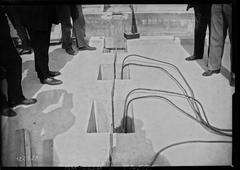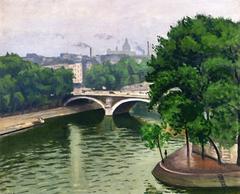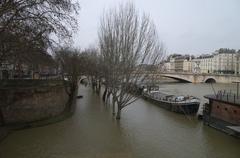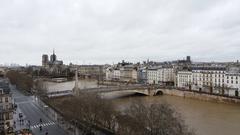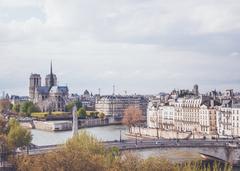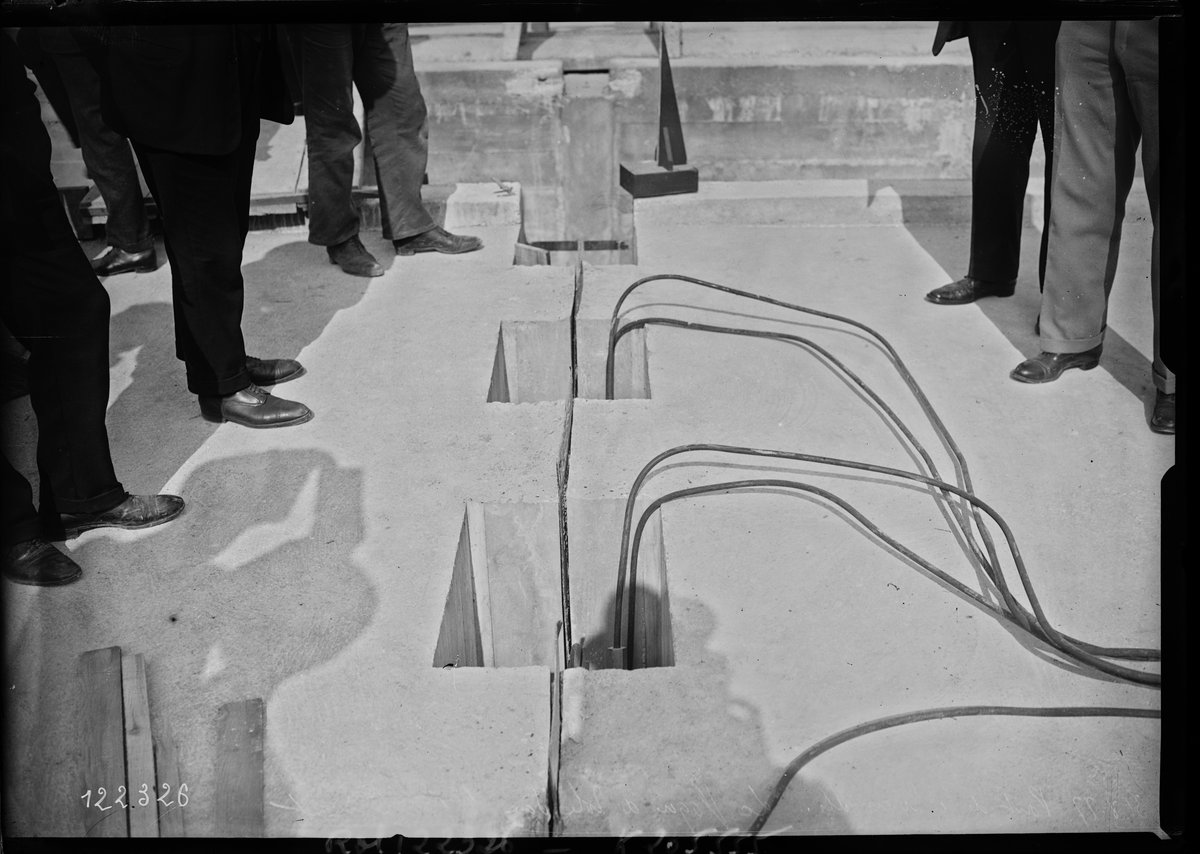
Pont de la Tournelle Paris: Complete Visiting Guide, Hours, Tickets, and Tourist Information
Date: 14/06/2025
Introduction
The Pont de la Tournelle is one of Paris’s most atmospheric and historically significant bridges, elegantly spanning the Seine to connect the Left Bank with the picturesque Île Saint-Louis. Far more than a simple crossing, it is a testament to Paris’s layered history, blending medieval origins, innovative engineering, and artistic grandeur. The bridge is renowned for its asymmetrical design, its breathtaking views of landmarks such as Notre-Dame Cathedral, and the monumental statue of Sainte Geneviève, Paris’s patron saint. This guide provides everything you need to know for a memorable visit, from historical insights to practical visitor tips.
For official updates and more information on Paris’s historic sites, consult the Paris Tourism Office and Seine River Navigation Authority.
Table of Contents
- Introduction
- History and Significance of Pont de la Tournelle
- Architectural and Artistic Highlights
- Cultural Importance and Urban Integration
- Visiting Pont de la Tournelle
- Travel Tips and Practical Advice
- Frequently Asked Questions (FAQ)
- Additional Resources and References
History and Significance of Pont de la Tournelle
Medieval Origins and the “Tournelle” Name
The Pont de la Tournelle derives its name from a medieval watchtower (“tourelle”) that once guarded the river entrance to Paris on the Left Bank. The turret, part of King Philippe Auguste’s 12th-century fortifications, underscored the city’s defensive priorities and river control. Over centuries, the site evolved from a strategic fortress to a vital crossing point, reflected in both the bridge’s name and its historic significance (travelfranceonline.com).
Evolution of the Bridge: From Wood to Stone to Concrete
The first bridge at this location was a wooden structure built in 1370. Vulnerable to the Seine’s floods, it was destroyed and rebuilt multiple times until Christophe Marie, a prominent engineer, oversaw the construction of a more robust stone bridge in 1656. This six-arch bridge proved resilient but posed navigation challenges due to its low clearance. Persistent flooding and evolving urban needs led to the demolition of the old bridge after the 1910 flood (travelfranceonline.com).
The present Pont de la Tournelle, completed in 1928, was designed by engineers Deval, Lang, and Retraint. Utilizing reinforced concrete for structural strength and faced with stone to harmonize with historic surroundings, the bridge measures about 120 meters in length and 23 meters in width. Its asymmetrical design and large central arch reflect both the practical demands of river navigation and the aesthetic sensibilities of early 20th-century Paris (gezibilen.com).
The Sainte Geneviève Statue
A defining feature of the bridge is the monumental statue of Sainte Geneviève, sculpted by Paul Landowski, who is also known for Christ the Redeemer in Rio de Janeiro. The statue, atop a 15-meter-high pylon on the Left Bank, depicts the saint protecting a child who holds a ship, symbolizing Paris’s emblem. This powerful image reinforces the bridge’s role as both physical and symbolic guardian of the city (travelfranceonline.com).
Architectural and Artistic Highlights
The Pont de la Tournelle’s unique asymmetrical layout, with a prominent central arch and two smaller side arches, responds to the riverbanks’ varying widths and the local urban landscape. Built with reinforced concrete and clad in pale limestone, the bridge seamlessly blends modern engineering with traditional Parisian aesthetics (gezibilen.com).
The bridge’s central pylon, crowned by the statue of Sainte Geneviève, creates an iconic silhouette. Subtle geometric motifs on the balustrades and pylons add understated elegance, while the statue itself commands attention as both an artistic and spiritual landmark. At night, the bridge is dramatically illuminated, enhancing its visual appeal and making it a favorite for evening strolls and photography (Paris Seine).
Cultural Importance and Urban Integration
Pont de la Tournelle is more than an architectural feature; it is woven into Paris’s cultural and urban fabric. It forms a direct link between the vibrant Left Bank and the tranquil Île Saint-Louis, offering a gateway to the island’s charming streets, historic houses, and artisanal shops. The bridge’s strategic location affords panoramic views of Notre-Dame Cathedral and the Seine, cementing its status as one of the city’s most scenic and photographed spots (gezibilen.com).
The bridge is also closely associated with Parisian resilience, having withstood floods, wars, and urban transformation. Its enduring presence and frequent depiction in art and literature underscore its role as a symbol of the city’s spirit (travelfranceonline.com).
Visiting Pont de la Tournelle
Hours, Tickets, and Accessibility
- Visiting Hours: Open 24 hours a day, 7 days a week, year-round. There are no restrictions on access (Paris Top Ten).
- Tickets/Fee: The bridge is public and entirely free to access; no tickets or permits are required.
- Accessibility: Wide sidewalks ensure the bridge is accessible for pedestrians, strollers, and wheelchairs. Some approaches, especially on the Île Saint-Louis side, may have cobblestones or slight inclines (Paris Top Ten).
Getting There
- Metro: Closest stations are Pont Marie (Line 7), Sully-Morland (Line 7), and Saint-Paul (Line 1).
- RER: Saint-Michel–Notre-Dame (Line B) for connections to airports.
- Bus: Lines 21, 38, 47, 85, and 96 serve the area.
- Walking: The bridge is within easy walking distance of Notre-Dame Cathedral, the Latin Quarter, and the Marais (Paris Top Ten).
- Parking: Limited; public garages are available near Place Maubert and Quai de la Tournelle, but walking or public transport is recommended.
Nearby Attractions
- Notre-Dame Cathedral: Iconic Gothic masterpiece a short stroll from the bridge (Paris Seine).
- Île Saint-Louis: Known for its elegant 17th-century architecture, boutiques, and the renowned Berthillon ice cream.
- Latin Quarter: Lively district filled with cafés, bookstores, and the Sorbonne.
- Hôtel de Miramion and Hôtel de Nesmond: Notable examples of classical Parisian architecture along Quai de la Tournelle.
- La Tour d’Argent: Historic restaurant offering panoramic Seine views and gourmet dining.
- Other Bridges: Pont Marie, Pont Louis-Philippe, and Pont Saint-Louis are all nearby and worth exploring.
Guided Tours and Special Events
- Many Paris walking tours and Seine river cruises include Pont de la Tournelle as a highlight (Paris Seine).
- During summer, the bridge and nearby quays often feature street performers and may host cultural events, especially during Paris’s Nuit Blanche and Fête de la Musique (Paris Insiders Guide).
Travel Tips and Practical Advice
- Best Times to Visit: Early morning or late evening for fewer crowds and optimal light for photography. Sunset offers spectacular views of Notre-Dame and the Seine (Paris Top Ten).
- Photography: Bring a camera for panoramic shots, especially at golden hour or at night when the bridge is illuminated.
- Weather: In June, expect mild to warm weather with occasional rain—bring light layers and a compact umbrella (TripSavvy).
- Accessibility: All sidewalks on the bridge are wide and generally accessible, but nearby cobblestone streets may present challenges for wheelchairs or strollers.
- Facilities: No public restrooms or seating on the bridge; cafés and public parks nearby offer amenities.
- Safety: Watch for moderate vehicular traffic and be vigilant for pickpockets during busy periods.
- Events: June features festivals such as Fête de la Musique and Paris Jazz Festival. Evening picnics on the quays are popular (Paris Insiders Guide).
- Family-Friendly: The area is suitable for families, with open spaces and access to nearby attractions.
Frequently Asked Questions (FAQ)
Q: What are Pont de la Tournelle’s visiting hours?
A: The bridge is open 24/7 with free access at all times.
Q: Is there an entrance fee or ticket required?
A: No, access to Pont de la Tournelle is completely free.
Q: Are guided tours available?
A: While there are no dedicated tours for the bridge itself, many walking tours and Seine river cruises include it as a highlight.
Q: Is the bridge accessible for people with disabilities?
A: Yes, the bridge has wide sidewalks and sloped approaches, though some adjacent streets have cobblestones.
Q: What are the best times to visit to avoid crowds?
A: Early mornings and late evenings, especially on weekdays or during shoulder seasons, are less crowded.
Q: Are there nearby places to eat or relax?
A: Yes, numerous cafés, bakeries, and the renowned La Tour d’Argent restaurant are close by.
Visuals and Media
For the best experience, explore high-resolution images and virtual tours of Pont de la Tournelle, its statue of Sainte Geneviève, and panoramic views of Notre-Dame Cathedral. These are available on official tourism websites and local guides. Including images with descriptive alt text (e.g., “Pont de la Tournelle at sunset,” “Statue of Sainte Geneviève”) enhances both engagement and search visibility.
Additional Resources and References
- Paris Tourism Office
- Seine River Navigation Authority
- Travel France Online: Pont de la Tournelle Paris Bridge Facts
- Gezibilen: Pont de la Tournelle
- Paris Top Ten: Pont de la Tournelle
- Paris Seine: Pont de la Tournelle Paris
- TripSavvy: June in Paris Weather and Events Guide
- Paris Insiders Guide: Paris Events in June
- Bateaux-Mouches: Seine River Cruises
Conclusion
Pont de la Tournelle stands as a living monument to Parisian history, resilience, and artistry. Its unique design, sweeping views, and rich heritage make it a must-visit destination for anyone exploring Paris. Open around the clock and free to access, the bridge is perfect for spontaneous visits, stunning photography, and discovering the vibrant life along the Seine. Use the tips and information in this guide to plan your journey, and consider pairing your visit with a Seine river cruise or a stroll through the surrounding historic neighborhoods.
For more travel tips and updates on Paris attractions, download the Audiala mobile app, explore additional guides on our website, and follow us on social media. Begin your Paris adventure at Pont de la Tournelle—where history, art, and the heart of the city converge.
